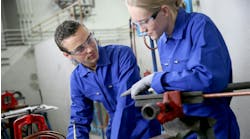Latest from Management
Sponsored
It's not news that the hydronics industry is changing. The news is that terminology once limited to computer-controlled HVAC systems found in large commercial buildings is now being applied to hydronics.
For example, earlier this year I read in CONTRACTOR that Uponor would "put on a session on its BACnet-based communicating control system" at the Radiant Professionals Alliance (RPA), formerly known as the Radiant Panel Association, national convention. RPA is dedicated to the education of the hydronics industry. Communicating controls and their terminology are also promoted by other hydronics industry standard names such as Taco, Honeywell and Tekmar.
Wow, I thought … I've been in this business for more than 20 years, and I don't know what a BACnet is. I'm pretty sure I know what a communicating control system is, but I'm not 100% sure what that entails these days either.
So with some research, and the help of Jeff Wiedemann, Uponor's product manager of controls and software, I came up with the following explanations of what a communicating control system is made of, including what BACnet is. Get ready for terms such as proprietary protocol and open platform to become as familiar as cell phone and laptop. (Remember when those had us wondering?)
Here's my list, not alphabetical, but hopefully in a useful order:
Building automation: A network of devices that monitor and control the mechanical, lighting, fire and security systems in a building. The intent is to have a safe and comfortable building while reducing energy and maintenance costs.
Network: A collection of computers and other devices connected, so that information is shared among them.
Device: Receives information and takes action as a result. Examples can be as simple and old-fashioned as a thermostat or relay. A thermostat turns on heating or cooling as a result of temperature information.
Protocol: A set of rules used by computers and devices to share data with each other across a network for network communication.
Proprietary protocol: Network communication that can be used only by those who purchase it, and only by devices that are made to use it. In the world of ordinary personal computers, Apple and Windows are proprietary. In heating and air conditioning, manufacturers have preferred proprietary protocols to protect their system from competitors.
Open protocol: Network communication that can be used for free. The American Society of Heating, Refrigeration and Air Conditioning Engineers (ASHRAE) encourages open protocol.
Communication protocol: BACnet (Building and Automation and Control network) and LON (Local Operating Network) are the two protocols most often used with HVAC systems. BACnet is an open protocol. LON is proprietary. Among users some love BACnet, some love LON.
Eschelon: The manufacturer of LON.
Tridium: A communications bridge that allows exchange of information between protocols, such as BACnet and LON. Tridium is a proprietary platform.
Platform: A place to launch software. An example is the familiar Microsoft Windows found on many personal computers.
LAN (Local Area Network): It covers a small physical area, like a home, office, or small groups of buildings.
Backbone: The main network lines that connect several local area networks (LANs) together. The result is a wide area network (WAN) linked by a backbone connection.
Ethernet: A family of networking technologies for local area networks (LANs).
DDC (Direct Digital Control): Automated control by a computer.
Bus: A pathway for data to move inside a computer or between computers.
Sequencer: The brain that decides the order in which things happen.
Controller: Same as "device" above.
Sensor: Measures information (temperature, humidity, pressure, status, etc.) and shares it with devices (see above) to take action.
Gateway: A computer or a network that controls access to another computer or network.
VFD (Variable Frequency Drive): A controller that changes motor speed by changing signal frequency.
Front end: A device that humans use to communicate with a network, either to see what it is doing or to enter information. Examples are a personal computer, iPhone or LCD display.
Commissioning: Verifying that devices in a building automation system are wired correctly and follow the expected sequence when they operate together.
Programming: Giving a computer coded instructions so that it performs a detailed sequence of operations. This term is often misused in HVAC to mean to simply enter user preferences, such as "to program a thermostat" or other controller. This should probably be called simply "set-up."
Configuring: To set up or arrange.
Launch: To start.
Browser: A computer program that lets a person look at the information space known as the World Wide Web or the Internet. Examples or browsers are Internet Explorer and Firefox.
Web-enabled: Information that can be accessed with a browser.
Documentation: A record of system changes. Saves time when you have to go back, like keeping a record of changes on a mechanical diagram.
Training: Bringing plumbing and heating professionals from only mechanical work to installing and troubleshooting their own communicating controls!
You have probably heard all of the above terms. If you're like me, you pretended — certainly to others, and possibly to yourself — that you know what they mean. It's time to learn to use not only the terminology but also how to use the controls. Remember before the Internet and e-mail when you thought you didn't need to know how to type?
Carol Fey is a degreed technical trainer who has worked as a heating technician in Antarctica. She has published five books especially for the HVAC industry. Her website is: www.carolfey.com.
Carol Fey
Carol Fey is a technical trainer and writer, specializing in easy electricity, hydronics and troubleshooting books. She also writes about HVAC work in Antarctica.

